1 メディアタイプ
概要
メディアとは、Zabbix からの通知やアラートの送信に使用される配信チャンネルです。
いくつかのメディアタイプを設定することができます:
メディアタイプは、Administration → Media typesで設定します。

メディアタイプによっては、デフォルトのデータセットにあらかじめ定義されているものもあります。それらを動作させるためには、 パラメータを調整する必要があります。
設定したメディアタイプが動作するかどうかは、最後の列にある Test をクリックしてテストすることができます。 (詳しくは、Media type testing を参照してください)
新しいメディアタイプを作成するには、Create media type ボタンをクリックします。メディアタイプの設定フォームが表示されます。
共通パラメーター
いくつかのパラメータは、すべてのメディアタイプで共通です。
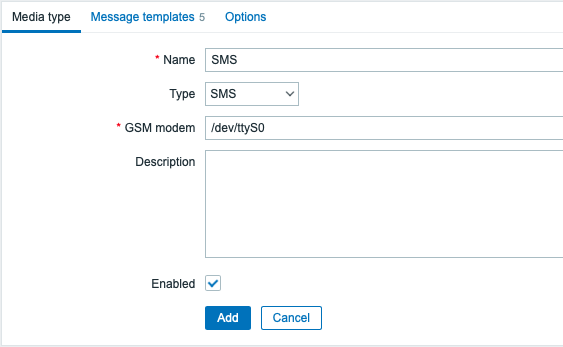
Media type タブでは、共通の一般属性があります:
| パラメータ | 説明 |
|---|---|
| Name | Name of the media type. |
| Type | Select the type of media. |
| Description | Enter a description. |
| Enabled | Mark the checkbox to enable the media type. |
メディア固有のパラメータについては、メディアタイプの各ページを参照してください。
Message templates タブでは、以下のイベントタイプのすべてまたは一部について、デフォルトの通知メッセージを設定できます:
- Problem
- Problem recovery
- Problem update
- Service
- Service recovery
- Service update
- Discovery
- Autoregistration
- Internal problem
- Internal problem recovery
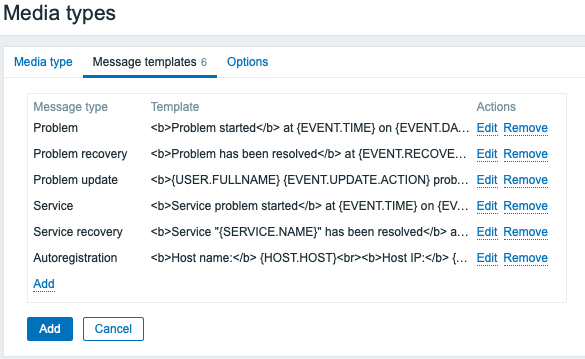
メッセージテンプレートをカスタマイズするには:
- Message templates タブで
 : をクリックすると、 Message template ポップアップウィンドウが開きます。
: をクリックすると、 Message template ポップアップウィンドウが開きます。 - 必要な Message type を選択し、Subject と Message のテキストを編集します。
- Add をクリックして、メッセージテンプレートを保存します。
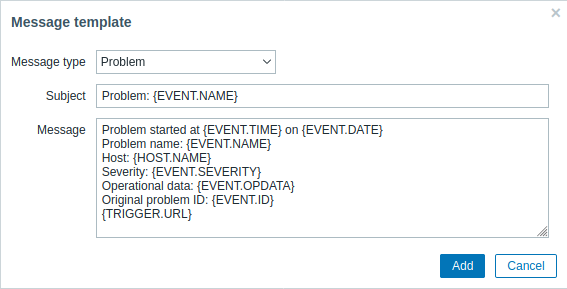
メッセージテンプレートのパラメータ:
| パラメータ | 説明 | ||||
|---|---|---|---|---|---|
| Message type | Type of an event for which the default message should be used. Only one default message can be defined for each event type. |
||||
| Subject | Subject of the default message. The subject may contain macros. It is limited to 255 characters. Subject is not available for SMS media type. |
||||
| Message | The default message. It is limited to certain amount of characters depending on the database type (see Sending messages for more information). The message may contain supported macros. In problem and problem update messages, expression macros are supported (for example, {?avg(/host/key,1h)}). |
||||
既存のメッセージテンプレートに変更を加えるには: Actions 列で
 をクリックして、テンプレートを編集します。
をクリックして、テンプレートを編集します。
または、
 をクリックして、メッセージテンプレートを削除します。
をクリックして、メッセージテンプレートを削除します。
特定のアクションに対して、カスタムメッセージテンプレートを定義することができます。
(詳細はaction operations を参照してください)
アクションの設定で定義されたカスタムメッセージは、メディアタイプのデフォルトメッセージテンプレートをオーバーライドします。
メッセージテンプレートの定義は、通知にデフォルトメッセージを使用しないWebhookやカスタムアラートスクリプトを含む、
すべてのメディアタイプで必須です。例えば、"Send message to Pushover webhook" アクションは、Pushover webhook用の
Problemメッセージが定義されていない場合、問題通知の送信に失敗します。
Options タブには、アラート処理の設定が含まれています。各メディアタイプで同じオプションセットを設定できます。
すべてのメディアタイプは並行して処理されます。同時セッションの最大数はメディアタイプごとに設定できますが、サーバ上の
アラータプロセスの総数は StartAlertersparameter によってのみ制限されます。
1 つのトリガーによって生成されたアラートは、順次処理されます。したがって、複数の通知は、複数のトリガーによって生成された
場合のみ、同時に処理される可能性があります。

| パラメータ | 説明 |
|---|---|
| Concurrent sessions | Select the number of parallel alerter sessions for the media type: One - one session Unlimited - unlimited number of sessions Custom - select a custom number of sessions Unlimited/high values mean more parallel sessions and increased capacity for sending notifications. Unlimited/high values should be used in large environments where lots of notifications may need to be sent simultaneously. If more notifications need to be sent than there are concurrent sessions, the remaining notifications will be queued; they will not be lost. |
| Attempts | Number of attempts for trying to send a notification. Up to 100 attempts can be specified; the default value is '3'. If '1' is specified Zabbix will send the notification only once and will not retry if the sending fails. |
| Attempt interval | Frequency of trying to resend a notification in case the sending failed, in seconds (0-3600). If '0' is specified, Zabbix will retry immediately. Time suffixes are supported, e.g. 5s, 3m, 1h. |
メディアタイプのテスト
設定したメディアタイプが動作するかどうかをテストすることが可能です。
例えば、電子メールのメディアタイプをテストするには:
- メディアタイプのlistで、該当する電子メールを見つけます。
- リストの最後の列で Test をクリックします。(テストウィンドウが開きます)
- 受信者 のアドレス、本文、およびオプションの件名を入力します。
- Test をクリックして、テストメッセージを送信します。
テストの成功または失敗のメッセージが同じウィンドウに表示されます。:
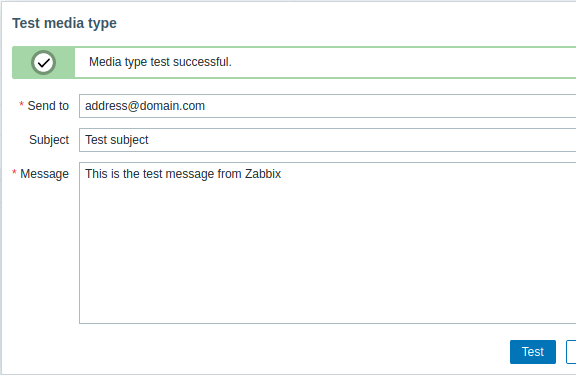 |
|---|
**Webhook **
webhook のメディアタイプをテストするには:
- メディアタイプのlistで、関連する webhook を見つけます。
- リストの最後の列で Test をクリックします。 (テストウィンドウが開きます)
- 必要であれば、webhook パラメータ値を編集します。
- Test をクリックします。
デフォルトでは、Webhook のテストは設定時に入力されたパラメータで実行されます。しかし、テストのために属性値を変更することは
可能です。テストウィンドウで値を交換または削除すると、テスト手順にのみ影響し、実際の Webhook 属性値は変更されません。
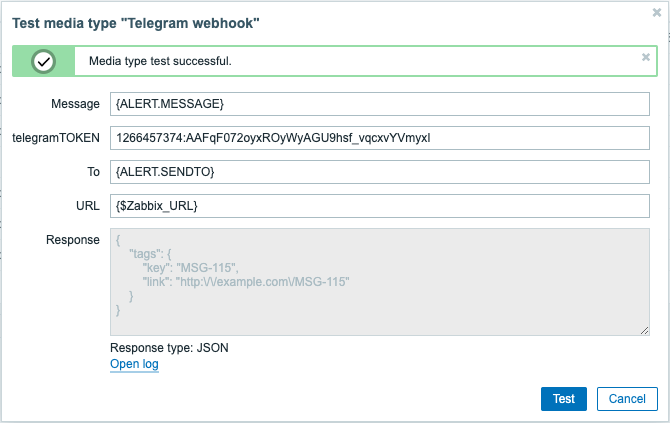 |
|---|
テストウィンドウを離れずにメディアタイプのテストログエントリーを表示するには
- Open log をクリックします。(新しいポップアップウィンドウが開きます)
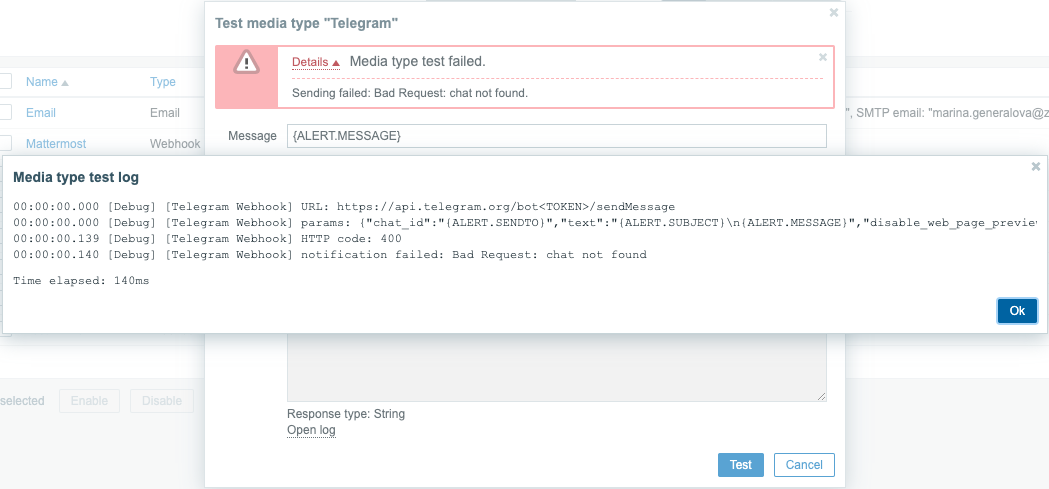 |
|---|
Webhookテストが成功した場合
- "Media type test successful. " のメッセージが表示されます。
- 灰色の Response フィールドにサーバーの応答が表示されます。
- レスポンスの種類(JSONまたはString)は、Response フィールドの下に表示されます。
Webhook テストが失敗した場合
- "Media type test failed. " というメッセージが表示され、その後に失敗の詳細が表示されます。
ユーザーメディア
あるメディアタイプの通知を受け取るには、そのメディアタイプの媒体(メールアドレス/電話番号/webhookユーザーIDなど)が
ユーザープロファイルに定義されている必要があります。例えば、webhook "X" を使ってユーザー "Admin" にメッセージを送る
アクションは、webhook "X" メディアがユーザープロファイルに定義されていない場合、常に何も送信されないことになります。
ユーザーメディアを定義するには:
- ユーザープロファイルにアクセスするか、または Administration → Users にアクセスし、ユーザーのプロパティフォームを開きます。
- メディアタブで以下をクリックします。

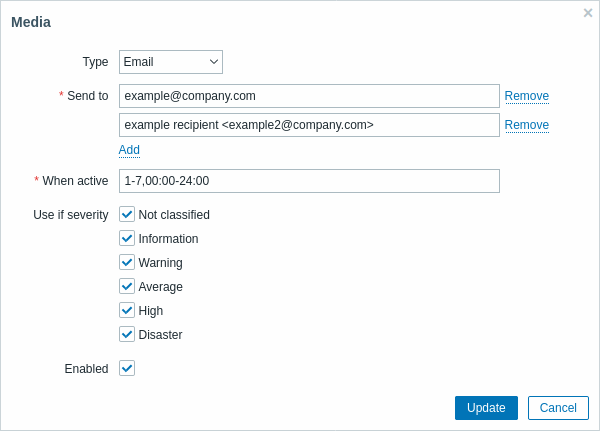
ユーザーメディアの属性:
| パラメータ | 説明 |
|---|---|
| Type | The drop-down list contains names of all configured media types. |
| Send to | Provide required contact information where to send messages. For an e-mail media type it is possible to add several addresses by clicking on  below the address field. In this case, the notification will be sent to all e-mail addresses provided. It is also possible to specify recipient name in the Send to field of the e-mail recipient in a format 'Recipient name <[email protected]>'. Note, that if a recipient name is provided, an e-mail address should be wrapped in angle brackets (<>). UTF-8 characters in the name are supported, quoted pairs and comments are not. For example: John Abercroft <[email protected]> and [email protected] are both valid formats. Incorrect examples: John Doe [email protected], %%"Zabbix\@\<H(comment)Q\>" [email protected] %%. below the address field. In this case, the notification will be sent to all e-mail addresses provided. It is also possible to specify recipient name in the Send to field of the e-mail recipient in a format 'Recipient name <[email protected]>'. Note, that if a recipient name is provided, an e-mail address should be wrapped in angle brackets (<>). UTF-8 characters in the name are supported, quoted pairs and comments are not. For example: John Abercroft <[email protected]> and [email protected] are both valid formats. Incorrect examples: John Doe [email protected], %%"Zabbix\@\<H(comment)Q\>" [email protected] %%. |
| When active | You can limit the time when messages are sent, for example, set the working days only (1-5,09:00-18:00). Note that this limit is based on the user time zone. If the user time zone is changed and is different from the system time zone this limit may need to be adjusted accordingly so as not to miss important messages. See the Time period specification page for description of the format. |
| Use if severity | Mark the checkboxes of trigger severities that you want to receive notifications for. Note that the default severity ('Not classified') must be checked if you want to receive notifications for non-trigger events. After saving, the selected trigger severities will be displayed in the corresponding severity colors, while unselected ones will be grayed out. |
| Status | Status of the user media. Enabled - is in use. Disabled - is not being used. |
